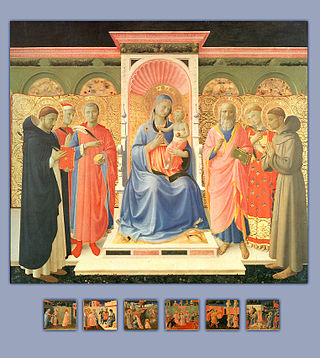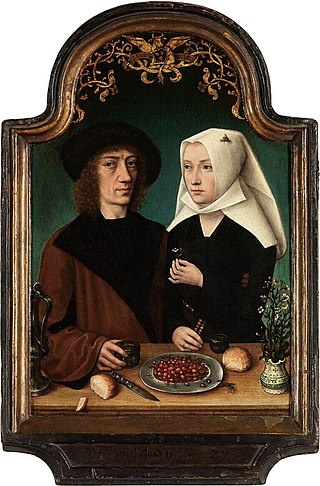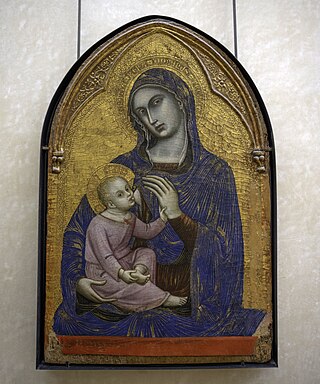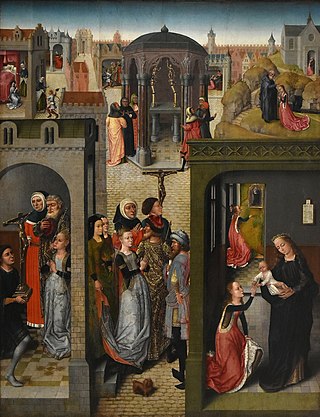
Adriaen Isenbrandt or Adriaen Ysenbrandt was a painter in Bruges, in the final years of Early Netherlandish painting, and the first of the Dutch and Flemish Renaissance painting of the Northern Renaissance. Documentary evidence suggests he was a significant and successful artist of his period, even though no specific works by his hand are clearly documented. Art historians have conjectured that he operated a large workshop specializing in religious subjects and devotional paintings, which were executed in a conservative style in the tradition of the Early Netherlandish painting of the previous century. By his time, the new booming economy of Antwerp had made this the centre of painting in the Low Countries, but the previous centre of Bruges retained considerable prestige.

Carlo Crivelli was an Italian Renaissance painter of conservative Late Gothic decorative sensibility, who spent his early years in the Veneto, where he absorbed influences from the Vivarini, Squarcione, and Mantegna. He left the Veneto by 1458 and spent most of the remainder of his career in the March of Ancona, where he developed a distinctive personal style that contrasts with that of his Venetian contemporary Giovanni Bellini.

In art, a sacra conversazione, meaning "holy conversation", is a genre developed in Italian Renaissance painting, with a depiction of the Virgin and Child amidst a group of saints in a relatively informal grouping, as opposed to the more rigid and hierarchical compositions of earlier periods. Donor portraits may also be included, generally kneeling, often their patron saint is presenting them to the Virgin, and angels are frequently in attendance.

Bernardo Daddi was an early Italian Renaissance painter and the leading painter of Florence of his generation. He was one of the artists who contributed to the revolutionary art of the Renaissance, which broke away from the conventions of the preceding generation of Gothic artists, by creating compositions which aimed to achieve a more realistic representation of reality. He was particularly successful with his small-scale works and contributed to the development of the portable altarpiece, a format that subsequently gained great popularity.

Joos van Cleve was a leading painter active in Antwerp from his arrival there around 1511 until his death in 1540 or 1541. Within Dutch and Flemish Renaissance painting, he combines the traditional techniques of Early Netherlandish painting with influences of more contemporary Renaissance painting styles.

Giampietrino, probably Giovanni Pietro Rizzoli, was a north Italian painter of the Lombard school and Leonardo's circle, succinctly characterized by S. J. Freedberg as an "exploiter of Leonardo's repertory."

Bartolomeo Cavarozzi (1587–1625), occasionally referred to as Bartolomeo Crescenzi, was an Italian caravaggisti painter of the Baroque period. Cavarozzi's work began receiving increased admiration and appreciation from art historians in the last few decades of the 20th century, emerging as one of the more distinct and original followers of Caravaggio. He received training from Giovanni Battista Crescenzi in Rome and later traveled to Spain alongside his master for a few years where he achieved some renown and was significant in spreading "Caravaggism" to Spain before returning to Italy. His surviving works are predominantly Biblical subjects and still-life paintings, although older references note he "was esteemed a good painter especially of portraits".

The Master of Frankfurt was a Flemish Renaissance painter active in Antwerp between about 1480 and 1520. Although he probably never visited Frankfurt am Main, his name derives from two paintings commissioned from patrons in that city, the Holy Kinship in the Frankfurt Historical Museum and a Crucifixion in the Städel museum.

The Master of the Virgo inter Virgines was an Early Netherlandish painter and designer of woodcuts active around Delft between 1483 and 1498. He is named for The Virgin and Child with Four Holy Virgins, an altarpiece of the Virgin with Saints Catherine, Cecilia, Ursula, and Barbara which formerly hung in the convent of Konigsveld, but which is now in the Rijksmuseum in Amsterdam. He was first distinguished individually in 1903; based upon the style of the altarpiece a considerable body of work has since been built up. The Master has been described as the most uncompromisingly "realist" of his contemporaries, and not at all concerned with elegance; he has also been called a forerunner of the Dutch school of painting.

The Nursing Madonna, Virgo Lactans, or Madonna Lactans, is an iconography of the Madonna and Child in which the Virgin Mary is shown breastfeeding the infant Jesus. In Italian it is called the Madonna del Latte. It was a common type in painting until the change in atmosphere after the Council of Trent, in which it was rather discouraged by the church, at least in public contexts, on grounds of propriety.

The Magdalen Reading is one of three surviving fragments of a large mid-15th-century oil-on-panel altarpiece by the Early Netherlandish painter Rogier van der Weyden. The panel, originally oak, was completed some time between 1435 and 1438 and has been in the National Gallery, London since 1860. It shows a woman with the pale skin, high cheek bones and oval eyelids typical of the idealised portraits of noble women of the period. She is identifiable as the Magdalen from the jar of ointment placed in the foreground, which is her traditional attribute in Christian art. She is presented as completely absorbed in her reading, a model of the contemplative life, repentant and absolved of past sins. In Catholic tradition the Magdalen was conflated with both Mary of Bethany who anointed the feet of Jesus with oil and the unnamed "sinner" of Luke 7:36–50. Iconography of the Magdalen commonly shows her with a book, in a moment of reflection, in tears, or with eyes averted.

The Werl Triptych is a triptych altarpiece completed in Cologne in 1438, of which the centre panel has been lost. The two remaining wings are now in the Prado in Madrid. It was long attributed to the Master of Flémalle, now generally believed to have been Robert Campin, although this identity is not universally accepted. Some art historians believe it may have been painted as a pastiche by either the workshop or a follower of Campin or the Master of Flémalle.

The St John Altarpiece is a large oil-on-oak hinged-triptych altarpiece completed around 1479 by the Early Netherlandish master painter Hans Memling. It was commissioned in the mid-1470s in Bruges for the Old St. John's Hospital (Sint-Janshospitaal) during the building of a new apse. It is signed and dated 1479 on the original frame – its date of installation – and is today still at the hospital in the Memling museum.

The Master of the Legend of Saint Catherine is the notname for an unknown late 15th century Early Netherlandish painter. He was named after a painting with Scenes from the Legend of Saint Catherine, now kept in the Royal Museums of Fine Arts of Belgium. He was active between c. 1470 and c. 1500, probably around Brussels.

The Master of Delft was a Dutch painter of the final period of Early Netherlandish painting, whose name is unknown. He may have been born around 1470. The notname was first used in 1913 by Max Jakob Friedländer, in describing the wings of a Triptych with the Virgin and Child with St Anne with the central panel by the Master of Frankfurt, which is now in Aachen. This has donor portraits of an identifiable family from Delft, that of the Burgomaster of Delft, Dirck Dircksz van Beest Heemskerck (1463–1545), with his wife and children.

The Mystic Marriage of St. Catherine is a c. 1480 oil-on-oak painting by the Early Netherlandish painter Hans Memling, now in the Metropolitan Museum of Art, New York. The Virgin Mary sits on a throne in a garden holding the Child Jesus in her lap. Mother and child are flanked by angels playing musical instruments, with St Catherine of Alexandria to the left opposite St Barbara on the right. The male figure standing slightly behind the celestial group presumably commissioned the painting as a devotional donor portrait.

The Holy Kinship is a circa 1495 oil on panel painting of Holy Kinship by the workshop of the renaissance artist Geertgen tot Sint Jans in the collection of the Rijksmuseum.

The four capital virgins, Latin: (quattuor) virgines capitales, are a group of virgin martyrs of the early church. In literature they are also called main virgins or excellent virgins. These are: Saint Catherine of Alexandria, Saint Margaret of Antioch, Saint Barbara and Saint Dorothea. Three of them – i. e. Saint Catherine, Saint Margaret and Saint Barbara – belong to the Fourteen Holy Helpers.
The Madonna and Child with Saints are the subject of several artworks.

The Triptych with the Virgin and Child, Saints and Donors is a triptych depicting the Virgin Mary and Child Jesus, with several saints and an unidentified donor couple by the Master of Delft, created c. 1500-1510. It belongs to the Rijksmuseum, in Amsterdam, but is on long-term loan to the Museum Catharijneconvent, in Utrecht. The iconography of the central panel is unusual, and its meaning disputed.




















